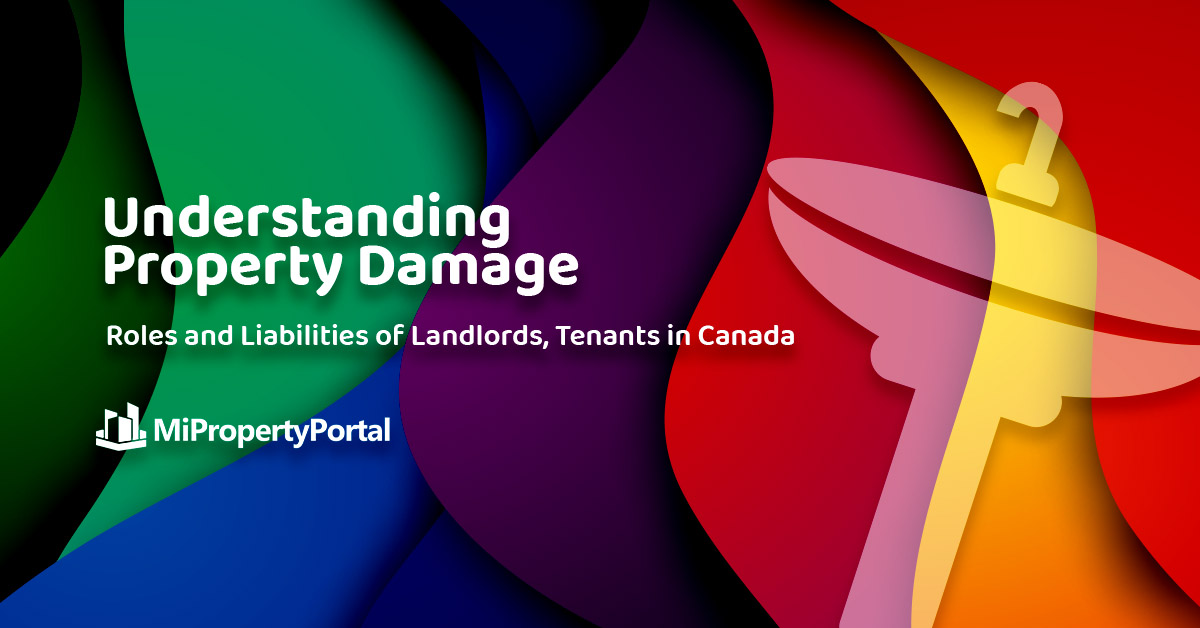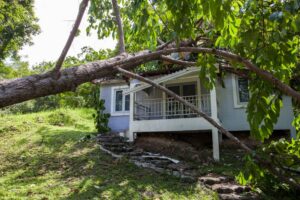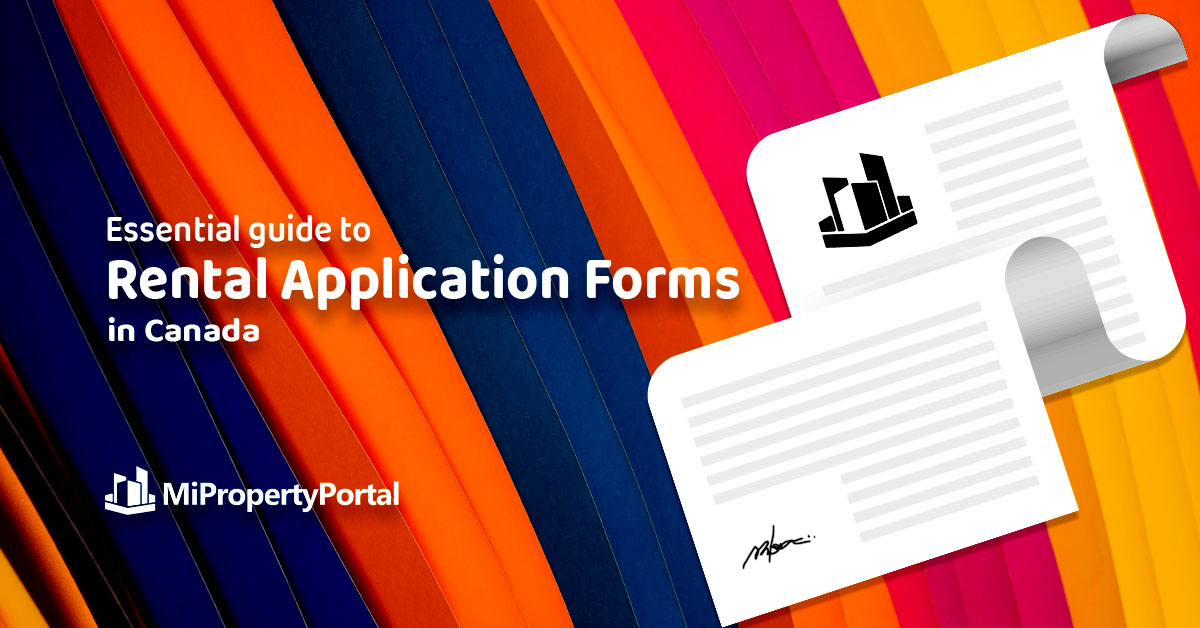In Guide
Understanding Property Damage : Roles and Liabilities of Landlords, Tenants in Canada

Dealing with property damage as a Landlord in Canada can be daunting. It can arise from natural disasters, accidents, or negligent acts. When damage occurs, it’s crucial to determine who bears the responsibility and how the situation can be resolved.
The Residential Tenancies Act (RTA) outlines the responsibilities of both tenants and landlords for the repair and maintenance of the rental property.
This article will explore the complexities of damage and the legal responsibilities of landlords, tenants, and neighbours.
What is Property Damage?
Property damage refers to any harm caused to real or personal property, including buildings, structures, or belongings.
Normal Wear and Tear vs Property Damage
Any minor damage that results from fair, regular use that isn’t detrimental to the unit’s viability is normal wear and tear. It becomes property damage when there is a noticeable difference in the quality of the rental unit due to voluntary or negligent behaviour.
The following examples might give you a clear idea about the difference between the two.
| Normal Wear And Tear | Damage |
|
|
Types of Property Damage
Property damage can manifest in various forms, including:
- Structural damage: This refers to harm inflicted upon the physical integrity of a building or its components, such as walls, foundations, or roofs.
- Water damage: This occurs as a result of water leaks, floods, or plumbing issues. This kind of damage can lead to significant deterioration and even mould growth.
- Fire damage can cause severe destruction and compromise a property’s safety and structural stability.
- Vandalism: This encompasses intentional destruction, graffiti, or property defacement.
- Theft or burglary: Property damage can also result from criminal activities like theft or burglary involving stolen belongings, damaged locks, or forced entry.
Common Causes of Property Damage
Understanding the common causes of damage of property is crucial for prevention and mitigation. Property damage can occur due to various reasons, including:
- Accidents: Accidents can often lead to damage of property, such as vehicle collisions, falling objects, or electrical failures.
- Natural disasters: Natural disasters are another significant cause, with floods, earthquakes, hurricanes, and storms capable of causing extensive damage to properties.
- Negligence: Negligence also plays a role in damage of property, where failing to maintain the property properly, neglecting repairs, or disregarding safety measures can result in significant harm.
Roles and Liabilities of Landlords, Tenants and Neighbours
Responsibilities of Landlords
A landlord is responsible for maintaining the condition of a rental property.
(i) The landlord must keep everything they give the tenant in functioning order. This includes:
- Appliances that use electrical, plumbing, or heating systems
- Carpets in the apartment or common spaces
- Ceilings, walls, and roofs
- Doors, windows, locks, and lighting
- Pools, patios, laundry rooms, pathways, and garages
(ii) The landlords are responsible for repairing or replacing items that cease to function properly due to normal wear and tear or breakage. However, they are not obligated to provide newer or better models when replacing such items.
(iii) Landlords also have an obligation to ensure that the rental property meets building codes and safety regulations as outlined in municipal by laws or provincial maintenance standards.
(iv) They may perform regular inspections and address maintenance issues promptly, but they must provide written notice to the tenant at least 24 hours before entering the premises. The written notice must include the following:
- The reason why the landlord wants to enter
- The date the landlord will enter and the specific time of entry (Between 8 a.m. and 8 p.m.)
Responsibilities of Tenants
Tenants, on the other hand, have their own set of responsibilities.
(i) They should promptly report any property damage to the landlord or management to ensure appropriate actions can be taken on time.
(ii) Tenants should take reasonable care of the property to prevent damage.
(iii) Tenant is responsible for maintaining the rental unit’s cleanliness.
(iv) Proper and responsible use of appliances and fixtures is encouraged to minimize the risk of accidents.
(v) Tenant is to Repair or Reimburse for any damage caused by their actions or negligence.
(vi) Tenants should follow the terms and conditions outlined in the lease agreement.
Failure to comply with these responsibilities may result in eviction mainly if intentional damage occurs, the tenant fails to pay for repairs, or the unit is used for purposes other than residential use that could result in significant damage.
For property damage disputes between landlords and tenants, the proof is essential. Any evidence the landlord has should be brought to the hearing in three copies. Some objects that could be used as proof to back up an application based on damage or a filthy unit include:
- Printed images of the damage or the unit’s condition
- Copies of any written communications, including letters and notices of termination, that were exchanged between the landlord and the tenant
- Written estimates from licensed contractors detailing the price of cleaning or repairing the damage
- Receipts of the landlord’s expenditure to repair the rental property’s damage
Responsibilities of Neighbours
Neighbours also play a role in preventing damage of property and have their responsibilities.
Neighbour’s Responsibility to Prevent Damage
They should take reasonable measures to prevent damage to neighbouring properties by maintaining trees, fences, or structures that could pose a risk.
Neighbour’s Liability for Property Damage
If a neighbour’s actions or negligence result in property damage, they may be liable for the harm caused. For instance, trees or branches fall onto neighbouring properties, causing damage or injuries.

Learn about Property Damage Dos and Don’ts from the Brochure: Maintenance and Repairs by the Landlord and Tenant Board(LTB).
Introducing MIPP: The Ultimate Property Management Software in Canada
Do you want to make sure your Tenants and their activities are safe? Is your property susceptible to vandalism or property damage? Our software enables comprehensive tenant screening, allowing you to conduct background checks, verify credit histories, and review rental references effortlessly. By selecting the best tenants, you can reduce the risk of property damage and ensure a smooth rental experience.
As a leading property management software with a strong Canadian presence, MIPP offers a comprehensive suite of features to streamline your operations and maximize your rental property’s potential.
Property Damage Insurance Rules and Regulations Ontario Canada
Insurance coverage can play a significant role in resolving property damage disputes and mitigating financial burdens. Let’s explore some key aspects of insurance concerning damage of propertes .
Landlord’s Insurance
As a landlord, having appropriate insurance coverage is essential. Landlord insurance typically covers the property’s structure, liability protection, and loss of rental income.
It can help protect landlords financially in case of property damage caused by covered perils such as fire, vandalism, or natural disasters. Landlords should review their insurance policy carefully and understand its terms and coverage limits.
Tenant’s Insurance
While landlords have insurance for the property, tenants are generally responsible for insuring their personal belongings. Tenant’s or renter’s insurance offers coverage for a tenant’s personal property in case of damage or loss due to covered perils.
It also provides liability protection if the tenant unintentionally causes damage to the property or injures someone on the premises. Encouraging tenants to obtain renter’s insurance can help protect their belongings and reduce potential conflicts regarding damage of property.
Neighbour’s Insurance
Neighbours may wonder if their insurance covers property damage caused by a neighbour. In most cases, if the damage results from the neighbour’s negligence or intentional act, the affected neighbour’s insurance may cover the costs.
Individuals should consult their insurance providers to understand their policies’ specific terms and conditions.
Subrogation
Subrogation refers to the right of an insurance company to seek reimbursement from the party deemed responsible for the damage.
Suppose a tenant’s negligence causes property damage. In that case, the landlord’s insurance company may cover the repairs upfront and subsequently pursue reimbursement from either the tenant or their insurance provider through subrogation.
All parties involved in damaging property incidents must review their insurance policies, understand their coverage, and promptly report any incidents to their insurance providers. Compliance with insurance rules and regulations can help ensure smoother claim processes and alleviate potential financial burdens.
It’s important to note that subrogation rights can vary depending on local laws and the terms of insurance policies.
What to Do If You Have Any Questions About Property Damage in Canada?
If you need more information about this notice or your rights, contact the Landlord and Tenant Board (LTB) by:
Visiting their website with the following link: tribunalsontario.ca/ltb
Calling the LTB to speak to one of the Customer Service Officers:
Within the Toronto calling area: 416-645-8080
From outside Toronto: 1-888-332-3234
Note: Customer Service Officers are available Monday to Friday, except holidays, from 8:30 a.m. to 5:00 p.m.
You can also access their automated information menu at the above numbers, 24 hours a day, seven days a week.
FAQs
Q: Who holds the responsibility for property damage – landlord or tenant?
A: Determining responsibility for property damage involves considering various factors such as the cause of damage, lease agreements, and negligence. In general, landlords are responsible for maintaining the property, while tenants are accountable for damage resulting from their actions or negligence.
Q: Can tenants be held liable for property damage caused by natural disasters?
A: Typically, tenants cannot be held liable for property damage caused by natural disasters, as such events are beyond their control. However, it is vital for tenants to promptly report any damage to their landlord or property management to ensure appropriate actions are taken.
Q: What steps should I take if my neighbour’s negligence leads to property damage?
A: If your neighbour’s negligence causes property damage, openly communicating with them is advisable. Documenting the damage and any conversations you have with your neighbour. You may seek legal advice or mediation if communication fails to resolve the matter.
Q: Are landlords obligated to have insurance coverage for property damage?
A: Insurance requirements can vary depending on local laws and agreements, but landlords generally should have insurance coverage for damaging properties. This protects both the landlord and tenants in the event of unforeseen circumstances.
Q: How can I prevent property damage as a tenant or landlord?
A: Mitigating property damage requires regular maintenance, timely repairs, and effective communication. Tenants should promptly report any issues to their landlords, while landlords must address maintenance concerns and ensure habitable living conditions. Adhering to the terms outlined in the lease agreement is essential to foster a mutually respectful environment.



